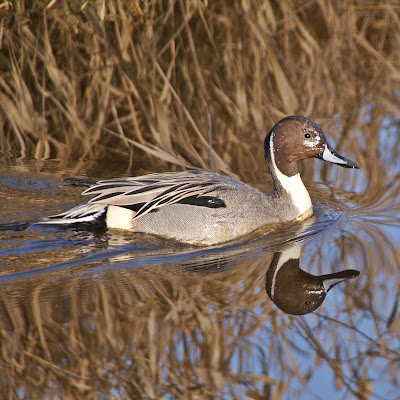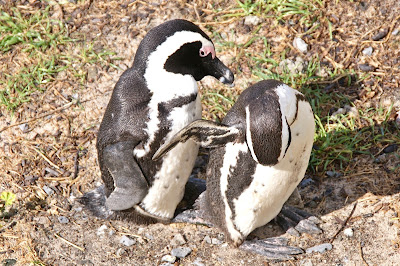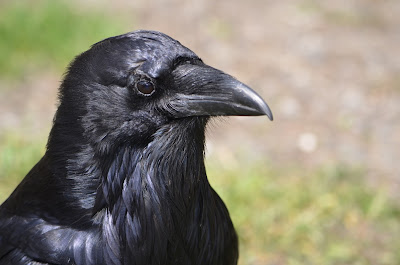The Blue Tit (Scientific name - Cyanistes caeruleus) also known as the European Blue Tit is a common bird throughout much of Europe. The range extends from Ireland and the U.K. to Southern and Central Scandinavia and East to Western Russia, Turkey and Northern Iran and Iraq. These birds tend to not migrate, however to move to areas of lower elevation in severe winters.
The Blue Tit has a short stubby dark bill, white cheeks on its face with a thin dark blue or black line through the eyes to the nape. The crown is blue and the back is olive yellow/green and wings are blue. Underparts are yellow and the top of the tail is blue.
Photos taken in Kensington Gardens, London, England in April 2013.
In addition to lighthouses, I have taken many photos of birds at home and on my travels. Thought I would share them as I have my lighthouse pictures. Hope you enjoy. Cheers, Neal
Saturday, September 21, 2013
Ostrich
The Ostrich (Scientific name - Struthio camelus) also known as the Common Ostrich is a large flightless bird native to Africa. These birds, which are now farmed in many parts of the world can reach a height of eight feet and weigh as much as 300 pounds, although the average is 230 pounds.
These birds have long necks and legs. The adult male has mostly black feathers with white tail and front. Young and females are mostly greyish brown in colour.
Top photo taken near Cape of Good Hope, South Africa in September 2010. Bottom photos taken at an Ostrich Ranch in Aruba in November 2010.
These birds have long necks and legs. The adult male has mostly black feathers with white tail and front. Young and females are mostly greyish brown in colour.
Top photo taken near Cape of Good Hope, South Africa in September 2010. Bottom photos taken at an Ostrich Ranch in Aruba in November 2010.
Wednesday, September 18, 2013
Northern Pintail
The Northern Pintail (Scientific name - Anas acuta), also just known as Pintail is a dabbling duck found in many parts of North America and Eurasia. In North America it nests as far North as Northern Canada and Alaska. It migrates South as far as Central America and into the North of South America.
The Northern Pintail male has a distinctive chocolate brown head and a long white neck and white underparts. The white extends up in a thin line to the vack of the head. Back is grey/brown with black on the wings. Bill is black with bluish sides. It has distinctive long black center tail feathers giving it its name. The female (in top photo) is basically brown and buff and does not have the distinctive tail feathers.
Photos were taken at the George C. Reifel Migratory Bird Sanctuary in January 2011 and April 2012.
The Northern Pintail male has a distinctive chocolate brown head and a long white neck and white underparts. The white extends up in a thin line to the vack of the head. Back is grey/brown with black on the wings. Bill is black with bluish sides. It has distinctive long black center tail feathers giving it its name. The female (in top photo) is basically brown and buff and does not have the distinctive tail feathers.
Photos were taken at the George C. Reifel Migratory Bird Sanctuary in January 2011 and April 2012.
Monday, September 16, 2013
Western Jackdaw
The Western Jackdaw (Scientific name - Corvus monedula), also known as the European Jackdaw or simply Jackdaw is a bird common to Europe, Western Asia and as far south as Northern Africa. It is a passerine bird in the Crow family. They are found usually in areas of farmland or open woodlands but also in urban areas.
The Jackdaw is a mainly black and grey bird with the grey predominate on its nape. The black is a shiny black.
Photos were taken in April 2013 at Zaanse Schans in the municipality of Zaanstad, North Holland, Netherlands.
The Jackdaw is a mainly black and grey bird with the grey predominate on its nape. The black is a shiny black.
Photos were taken in April 2013 at Zaanse Schans in the municipality of Zaanstad, North Holland, Netherlands.
Saturday, September 14, 2013
Ring Necked Pheasant
The Ring Necked Pheasant (Scientific name - Phasianus colchicum) also known as the Common Pheasant is a large game bird that is native to Asia. It is found in Asia from the Black and Caspian Seas east to China and Korea. It has been introduced to many other parts of the world and was introduced to North America in the 1880's. It is now found throughout most of North America as far North as central British Columbia and Alberta and South into Northern Mexico. While these birds can fly, they often run on the ground when startled.
The male is a very colourful bird with a red and bare face, iridescent green head, white ring around the neck and a maroon breast. Back is brown with black and white spots and the tail is long and barred. The female is plain in colour, mainly mottled brown with black spots and a long barred tail.
Top photo taken in Edison, Washington in May 2011, bottom photos taken in Langley, Washington in September 2013.
 |
| Male |
The male is a very colourful bird with a red and bare face, iridescent green head, white ring around the neck and a maroon breast. Back is brown with black and white spots and the tail is long and barred. The female is plain in colour, mainly mottled brown with black spots and a long barred tail.
Top photo taken in Edison, Washington in May 2011, bottom photos taken in Langley, Washington in September 2013.
 |
| Female |
Monday, September 9, 2013
Pine Siskin
The Pine Siskin (Scientific name - Spinus pinus) is a small songbird in the finch family. It is often found around backyard feeders. As its name suggests it breeds in mixed coniferous forest areas. It breeds in most of Canada, Alaska and the Northern part of Continental U.S. Some migrate as far south as Mexico. This species is unusual in that their migration is variable, perhaps due to food availability, and they migrate in large numbers some years and not in others. The Pine Siskin is a small bird, with heavy streaking on its underbelly and head. They have white and yellow patches on their wings. They have a short notched tail and a sharp pointed bill. Some (like those in the photos) have green colouration similar to that of the European Siskin. Top two photos taken in Abbotsford, B.C. in November 2015 and the bottom photos taken in Whistler, B.C. in September 2013.


Macaroni Penguin
The Macaroni Penguin (Scientific name - Eudyptes chrysolophus) is one of the most abundant species of penguins in the world. They are found in the Antarctic and Sub-Antarctic. Colonies are found on the Antarctic Penninsula, islands around Cape Horn, the Falklands, South Georgia, South Sandwich, South Orkney, South Shetland, Bouvetoya, Prince Edward, Marion, Crozet, Kerguelen, Heard Island and Macquarie Island. They alwo range as far as Southern Australia, New Zealand and South Africa in search of food.
The Macaroni Penguin is distinguished by its plume of yellow/orange feathers on its head. It has a thick orange/brown bill. The back and back of the flippers are black and it has a black face. The underparts are white.
This photo was taken in the Falkland Islands in March 2009 when this single Macaroni was observed in a large group of Gentoo Penguins.
The Macaroni Penguin is distinguished by its plume of yellow/orange feathers on its head. It has a thick orange/brown bill. The back and back of the flippers are black and it has a black face. The underparts are white.
This photo was taken in the Falkland Islands in March 2009 when this single Macaroni was observed in a large group of Gentoo Penguins.
Friday, September 6, 2013
Gentoo Penguin
The Gentoo Penguin (Scientific name - Pygoscelis papua) is a medium sized penguin that is found on the Antarctic Peninsula and also on a number of islands in the far Southern
Hemisphere (Falkland Islands; South Shetland Island; South Georgia Island; Heard Islands, Kerguelen Islands and Macquarie Islands).
The Gentoo Penguin has an orange/red beak, peach coloured feet and distinctive white patch over its eyes that looks like a bonnet.
Photos were taken in March 2009 in the Falkland Islands in the South Atlantic.
Hemisphere (Falkland Islands; South Shetland Island; South Georgia Island; Heard Islands, Kerguelen Islands and Macquarie Islands).
The Gentoo Penguin has an orange/red beak, peach coloured feet and distinctive white patch over its eyes that looks like a bonnet.
Photos were taken in March 2009 in the Falkland Islands in the South Atlantic.
Monday, September 2, 2013
African Penguin
The African Penguin (Scientific Name - Spheniscus demersus) is the only penguin that breeds in Africa. It is sometimes known as the Black Footed Penguin. They are found on islands from Namibia to South Africa and at a few colonies on mainland Africa. They are usually monogamous and live between 10 and 27 years. Their population has declined greatly since the start of the 20th Century and they are considered an endangered species.
The African Penguin has a black back and mainly white front. They have a black chin and face patch that is separated from the crown by a white band. They have a narrow black band that goes across their chest and down both flanks. They have a distinct pink patch above their eyes.
The photos were taken at Boulders Beach near Simon's Town, South Africa in August 2010.
The African Penguin has a black back and mainly white front. They have a black chin and face patch that is separated from the crown by a white band. They have a narrow black band that goes across their chest and down both flanks. They have a distinct pink patch above their eyes.
The photos were taken at Boulders Beach near Simon's Town, South Africa in August 2010.
Sunday, September 1, 2013
American Robin
The American Robin (Scientific name - Turdus migratorius) is the largest of the North American thrushes. It is a large songbird and found throughout all of North America. It is found in summer as far North as Alaska, the Yukon, North West Territories and Nunavut. It migrates south as far as Mexico and Central America and has been found in Greenland and also the Caribbean. Its diet consists of 40% invertebrates such as worms and grubs and is often seen on lawns, golf courses, etc. The remainder of its diet is berries and fruits.
The American Robin has a round body and fairly long tail. It is mostly grey/brown in colour with distinctive orange underparts. The head is darker than the rest of the body. It has white on the lower belly and under the tail that is more noticeable in flight.
Photos taken in May 2013 in Moose Jaw, Saskatchewan.
The American Robin has a round body and fairly long tail. It is mostly grey/brown in colour with distinctive orange underparts. The head is darker than the rest of the body. It has white on the lower belly and under the tail that is more noticeable in flight.
Photos taken in May 2013 in Moose Jaw, Saskatchewan.
Common Raven
The Common Raven (Scientific name -- Corvus coral), also sometimes known as the Northern Raven, is a large black passerine bird found across the Northern Hemisphere. It is found in the West of North America as far South as Mexico and Central America and across the whole of the North of Canada and into the Maritime Provinces. It is also found in Greenland, Europe and Northern Asia and as far South as North Africa.
The Common Raven is a very intelligent bird and good at solving problems, especially when looking for food. They are larger than Crows and distinguished by a thick neck and shaggy throat feathers. They are all black and have a strong powerful beak.
Top photo taken in Yellowstone National Park in Wyoming in May 2013, the bottom photos taken in Manning Provincial Park in British Columbia in May 2013.
The Common Raven is a very intelligent bird and good at solving problems, especially when looking for food. They are larger than Crows and distinguished by a thick neck and shaggy throat feathers. They are all black and have a strong powerful beak.
Top photo taken in Yellowstone National Park in Wyoming in May 2013, the bottom photos taken in Manning Provincial Park in British Columbia in May 2013.
Subscribe to:
Comments (Atom)




























